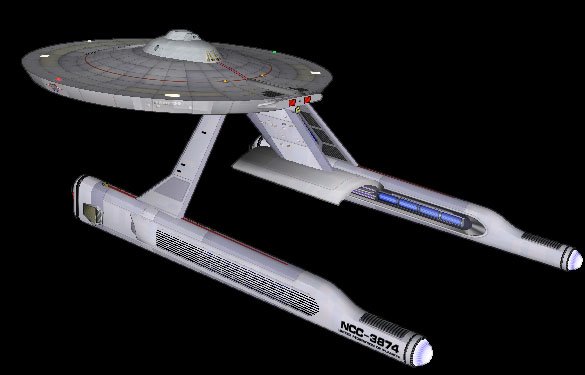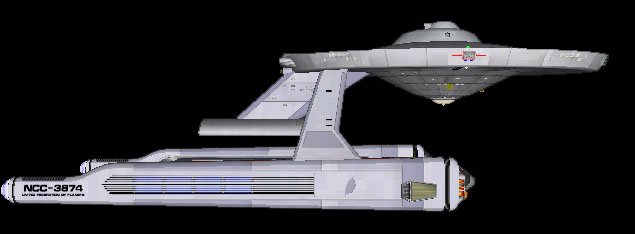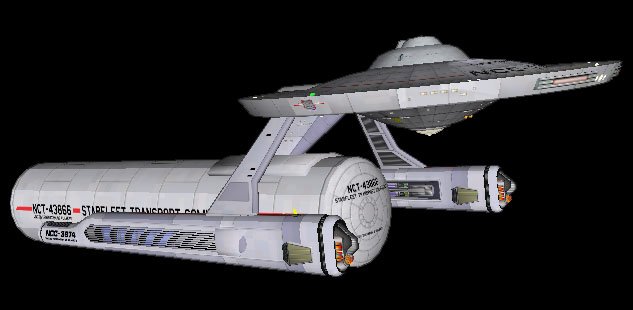

 U.S.S. Hirayama, Doppler class (2276 upgrade) NCC-3874.
U.S.S. Hirayama, Doppler class (2276 upgrade) NCC-3874. U.S.S. Hirayama NCC-3874:
U.S.S. Hirayama NCC-3874: Cadet Hawkins was assigned to the environmental station, monitoring the atmospheric composition on the ship and in the cargo pods. Specialist conditions for certain alien crewmembers were maintained in their quarters to allow them to be more comfortable. The colonial cargo pod was delivered without incident and the Hirayama was en route to deliver the Starfleet Security package when the sensors lit up at the science station.
Cadet Hawkins was assigned to the environmental station, monitoring the atmospheric composition on the ship and in the cargo pods. Specialist conditions for certain alien crewmembers were maintained in their quarters to allow them to be more comfortable. The colonial cargo pod was delivered without incident and the Hirayama was en route to deliver the Starfleet Security package when the sensors lit up at the science station.| NCC Registry | Name | Notes |
| 3831 | Doppler | Sub-class TMP refit. Authorised stardate |
| 3832 | Gaillot | |
| 3833 | Halley | |
| 3834 | Holden | |
| 3835 | Jeffrey | |
| 3836 | Kuiper | |
| 3837 | Oort | |
| 3838 | Pritchett | |
| 3839 | Savary | |
| 3840 | Struve | |
| 3841 | Vogel | |
| 3842 | Airy | |
| 3843 | Bondi | |
| 3844 | Chauvenet | |
| 3845 | Eddington | |
| 3846 | Gautier | |
| 3847 | Hencke | |
| 3848 | Hubble | |
| 3849 | Leavitt | |
| 3850 | Peale | |
| 3851 | Rittenhouse | |
| 3852 | Secchi | |
| 3853 | Tombaugh | |
| 3854 | Wolaston | |
| 3855 | Baade | |
| 3856 | Campbell | |
| 3857 | Columbo | |
| 3858 | Encke | |
| 3859 | Goldricke | |
| 3860 | Herschell | |
| 3861 | Humanson | |
| 3862 | Klepstra | |
| 3863 | Mitchell | |
| 3864 | Pickering | |
| 3865 | Ross | |
| 3866 | Shklovsky | |
| 3867 | Toscanelli | |
| 3868 | Wright | |
| 3869 | Bayer | |
| 3870 | Carrington | |
| 3871 | Kruger | |
| 3872 | Fracastor | |
| 3873 | Hale | |
| 3874 | Hirayama | 'Hawkins' Forge'. |
| 3875 | Jansky | |
| 3876 | Laplace | |
| 3877 | Newcomb | |
| 3878 | Popper | |
| 3879 | Sabine | |
| 3880 | Schmidt | |
| 3881 | Van Der Kamp | |
| 3882 | Von Zach | |
| 3883 | Chamberlain | |
| 3884 | Biela | |
| 3885 | Dollfus | |
| 3886 | Galle | |
| 3887 | Hayashi | |
| 3888 | Hubbard | |
| 3889 | Kaula | |
| 3890 | Lockyer | |
| 3891 | Palitzsch | |
| 3892 | Reber | |
| 3893 | Scheiner | |
| 3894 | Swift | |
| 3895 | Walker | |
| 3896 | Apian | |
| 3897 | Brovwer | |
| 3898 | Clark | |
| 3899 | Dreyer |






